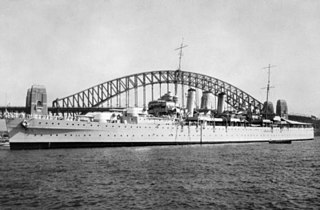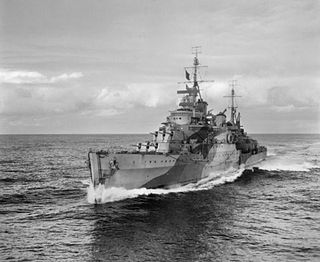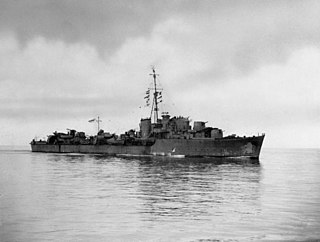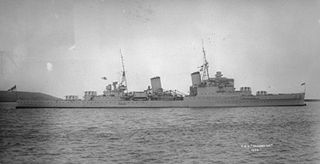
HMS Devonshire, pennant number 39, was a County-class heavy cruiser of the London sub-class built for the Royal Navy in the late 1920s. The ship spent most of her pre-World War II career assigned to the Mediterranean Fleet aside from a brief tour with the China Station. She spent the first two months of the Second World War in the Mediterranean until she was transferred to the Home Fleet and became flagship of a cruiser squadron. Devonshire took part in the Norwegian Campaign in mid 1940 and evacuated much of the Norwegian Government in June. Several months later, she participated in the Battle of Dakar, a failed attempt to seize the Vichy French colony of Senegal in September. The ship remained in the South Atlantic afterwards and supported Free French efforts to take control of French Equatorial Africa in addition to searching for German commerce raiders.

HMS Dorsetshire was a County-class heavy cruiser of the British Royal Navy, named after the English county, now usually known as Dorset. The ship was a member of the Norfolk sub-class, of which Norfolk was the only other unit; the County class comprised a further eleven ships in two other sub-classes. Dorsetshire was built at the Portsmouth Dockyard; her keel was laid in September 1927, she was launched in January 1929, and was completed in September 1930. Dorsetshire was armed with a main battery of eight 8 in (203 mm) guns, and had a top speed of 31.5 knots.

HMS Liverpool, named after the port city of Liverpool in north-west England, was a Town-class light cruiser of the Royal Navy in service from 1938 to 1952.

HMS Manchester was a Town-class light cruiser built for the Royal Navy in the late 1930s, one of three ships in the Gloucester subclass. Completed in 1938, she was initially deployed with the East Indies Station and had a relatively short but active career. When World War II began in September 1939, the cruiser began escorting convoys in the Indian Ocean until she was ordered home two months later. In late December Manchester began conducting patrols in the Norwegian Sea enforcing the blockade of Germany. Beginning in April 1940 the ship played a minor role in the Norwegian Campaign, mostly escorting convoys. She was assigned to anti-invasion duties in May–November in between refits.

HMS Griffin (H31) was a G-class destroyer, built for the Royal Navy in the mid-1930s. In World War II she took part in the Norwegian Campaign of April–May 1940 and the Battle of Dakar in September before being transferred to the Mediterranean Fleet in November. She generally escorted larger ships of the Mediterranean Fleet as they protected convoys against attacks from the Italian Fleet. Griffin took part in the Battle of Cape Matapan in March 1941 and the evacuations of Greece and Crete in April–May 1941. In June she took part in the Syria-Lebanon Campaign and was escorting convoys and the larger ships of the Mediterranean Fleet until she was transferred to the Eastern Fleet in March 1942.

HMS Havock was an H-class destroyer built for the British Royal Navy in the mid-1930s. During the Spanish Civil War of 1936–1939, the ship enforced the arms blockade imposed by Britain and France on both sides as part of the Mediterranean Fleet. During the first few months of the Second World War, Havock searched for German commerce raiders in the Atlantic Ocean and participated in the First Battle of Narvik during the Norwegian Campaign of April–June 1940 before she was transferred back to the Mediterranean Fleet in May where she escorted a number of convoys to Malta. The ship took part in the Battle of Cape Spada in July 1940, the Battle of Cape Matapan in March 1941 and the evacuation of Greece in April 1941. She was damaged during the Battle of Crete the following month, but participated in the Syria–Lebanon Campaign in June.

HMS Royal Sovereign was a Revenge-class battleship of the Royal Navy displacing 29,970 long tons (30,451 t) and armed with eight 15-inch (381 mm) guns in four twin-gun turrets. She was laid down in January 1914 and launched in April 1915; she was completed in May 1916, but was not ready for service in time to participate in the Battle of Jutland at the end of the month. She served with the Grand Fleet for the remainder of the First World War, but did not see action. In the early 1930s, she was assigned to the Mediterranean Fleet and based in Malta.

HMS Repulse was one of two Renown-class battlecruisers built for the Royal Navy during the First World War. Originally laid down as an improved version of the Revenge-class battleship, her construction was suspended on the outbreak of war because she would not be ready in time. Admiral Lord Fisher, upon becoming First Sea Lord, gained approval for her to resume construction as a battlecruiser that could be built and enter service quickly. The Director of Naval Construction (DNC), Eustace Tennyson-d'Eyncourt, quickly produced an entirely new design to meet Admiral Lord Fisher's requirements and the builders agreed to deliver the ship in 15 months. They did not quite meet that ambitious goal, but the ship was delivered a few months after the Battle of Jutland in 1916. Repulse and her sister ship Renown were the world's fastest capital ships upon completion.

HMAS Australia (I84/D84/C01) was a County-class heavy cruiser of the Royal Australian Navy (RAN). One of two Kent-subclass ships ordered for the RAN in 1924, Australia was laid down in Scotland in 1925, and entered service in 1928. Apart from an exchange deployment to the Mediterranean from 1934 to 1936, during which she became involved in the planned British response to the Abyssinia Crisis, Australia operated in local and South-West Pacific waters until World War II began.

HMS Kent, pennant number 54, was a County-class heavy cruiser built for the Royal Navy in the late 1920s. She was the lead ship of the Kent subclass. After completion the ship was sent to the China Station where she remained until the beginning of the Second World War, aside from a major refit in 1937–38. Kent hunted the German pocket battleship Admiral Graf Spee in the East Indies in late 1939 and then was reassigned to troop convoy escort duties in the Indian Ocean in early 1940. She was transferred to the Mediterranean in mid-1940, but was torpedoed shortly after arriving. The ship was under repair for a year and was then assigned to Home Fleet where she escorted convoys to and from North Russia for the next several years. In mid-1944 Kent escorted British aircraft carriers as their aircraft made attacks on German shipping and airfields in Norway. A few months later she was flagship of a force that intercepted a German convoy in Norwegian waters and sank two freighters and five escorts. The ship was paid off in early 1945 and placed in reserve until she was used as a target. Kent was sold for scrap in 1948.

HMAS Perth was one of three modified Leander-class light cruisers used by the Royal Australian Navy (RAN) during the early part of World War II. She was built for the Royal Navy (RN) in the mid-1930s and was commissioned as HMS Amphion in 1936. The ship spent the next several years as flagship of the Commander-in-Chief, Africa before she was transferred to the RAN in 1939 and renamed as HMAS Perth.

HMS Exeter was the second and last York-class heavy cruiser built for the Royal Navy during the late 1920s. Aside from a temporary deployment with the Mediterranean Fleet during the Abyssinia Crisis of 1935–1936, she spent the bulk of the 1930s assigned to the Atlantic Fleet or the North America and West Indies Station. When World War II began in September 1939, the cruiser was assigned to patrol South American waters against German commerce raiders. Exeter was one of three British cruisers that fought the German heavy cruiser Admiral Graf Spee, later that year in the Battle of the River Plate. She was severely damaged during the battle, and she was under repair for over a year.

HMAS Canberra (I33/D33), named after the Australian capital city of Canberra, was a Royal Australian Navy (RAN) heavy cruiser of the Kent sub-class of County-class cruisers. Constructed in Scotland during the mid-1920s, the ship was commissioned in 1928, and spent the first part of her career primarily operating in Australian waters, with some deployments to the China Station.

HMS Bonaventure was the lead ship of the Dido-class light cruisers built for the Royal Navy (RN) during the 1930s and during the Second World War. Completed in 1940, Bonaventure was assigned to the Home Fleet and participated in Operation Fish, the evacuation of British wealth from the UK to Canada in July. The ship made one short patrol in August into the North Atlantic to search for German blockade runners and followed that up by escorting an aircraft carrier as it conducted air strikes in Southern Norway in September. The next month she was tasked to provide cover for anti-shipping raids off the Norwegian coast. Bonaventure participated in the unsuccessful search for the German commerce raider Admiral Scheer in November and sustained weather damage that caused her to spend time in a dockyard for repairs. She was part of the escort force for Convoy WS 5A in December and helped to drive off another German commerce raider. While searching for stragglers from the convoy, the cruiser sank a German blockade runner.

HMS York was the lead ship of her class of two heavy cruisers built for the Royal Navy in the late 1920s. She mostly served on the North America and West Indies Station before World War II. Early in the war the ship escorted convoys in the Atlantic and participated in the Norwegian Campaign in 1940. York was transferred to the Mediterranean theatre in late 1940 where she escorted convoys and the larger ships of the Mediterranean Fleet. She was wrecked in an attack by Italian explosive motorboats of the 10th Flotilla MAS at Suda Bay, Crete, in March 1941. The ship's wreck was salvaged in 1952 and subsequently scrapped.

HMS Curacoa was a C-class light cruiser built for the Royal Navy during the First World War. She was one of the five ships of the Ceres sub-class and spent much of her career as a flagship. The ship was assigned to the Harwich Force during the war, but saw little action as she was completed less than a year before the war ended. Briefly assigned to the Atlantic Fleet in early 1919, Curacoa was deployed to the Baltic in May to support anti-Bolshevik forces during the British campaign in the Baltic during the Russian Civil War. Shortly thereafter the ship struck a naval mine and had to return home for repairs.

HMS Panther was a P-class destroyer built for the Royal Navy during the Second World War. After commissioning on 12 December 1941, she made a short trip to Iceland with the battleship King George V, then escorted a British convoy to India. In early April 1942, Panther rescued survivors from two cruisers sunk in the Indian Ocean, after which she took part in Operation Ironclad, the Allied invasion of Vichy French-held Madagascar, and sank a French submarine with another destroyer. Panther then returned to the Mediterranean, and participated in the Allied landings in North Africa, but was severely damaged in an air attack and had to undergo repairs in Gibraltar. After taking on survivors from the torpedoed SS Strathallan, Panther escorted two Allied convoys in the Atlantic. She next supported the Allied attack on Sicily, then sailed to the Aegean Sea in the Dodecanese Campaign. On 9 October 1943, Panther was sunk by German Stuka dive-bombers with 33 dead.

HMS Gloucester was one of the second batch of three Town-class light cruisers built for the Royal Navy during the late 1930s. Commissioned shortly before the start of World War II in August 1939, the ship was initially assigned to the China Station and was transferred to the Indian Ocean and later to South Africa to search for German commerce raiders. She was transferred to the Mediterranean Fleet in mid-1940 and spent much of her time escorting Malta Convoys. Gloucester played minor roles in the Battle of Calabria in 1940 and the Battle of Cape Matapan in 1941. She was sunk by German dive bombers on 22 May 1941 during the Battle of Crete with the loss of 722 men out of a crew of 807. Gloucester acquired the nickname "The Fighting G" after earning five battle honours in less than a year.

HMS Hawkins was the lead ship of her class of five heavy cruisers built for the Royal Navy during the First World War, although the ship was not completed until 1919. She was assigned to the China Station until 1928 and was briefly assigned to the Atlantic Fleet in 1929–1930, always serving as a flagship, before being placed in reserve. Hawkins was recommissioned in 1932 for service on the East Indies Station, but returned to reserve three years later. The ship was disarmed in 1937–1938 and converted into a cadet training ship in 1938.

HMS Forester was one of nine F-class destroyers built for the Royal Navy during the early 1930s. Although assigned to the Home Fleet upon completion, the ship was attached to the Mediterranean Fleet in 1935–36 during the Abyssinia Crisis. A few weeks after the start of World War II in September 1939, she helped to sink one German submarine and then participated in the Second Battle of Narvik during the Norwegian Campaign of 1940. Forester was sent to Gibraltar in mid-1940 and formed part of Force H where she participated in the attack on the Vichy French ships at Mers-el-Kébir and the Battle of Dakar between escorting the aircraft carriers of Force H as they flew off aircraft for Malta and covering convoys resupplying and reinforcing the island until late 1941. During this time the ship helped to sink another German submarine.





















